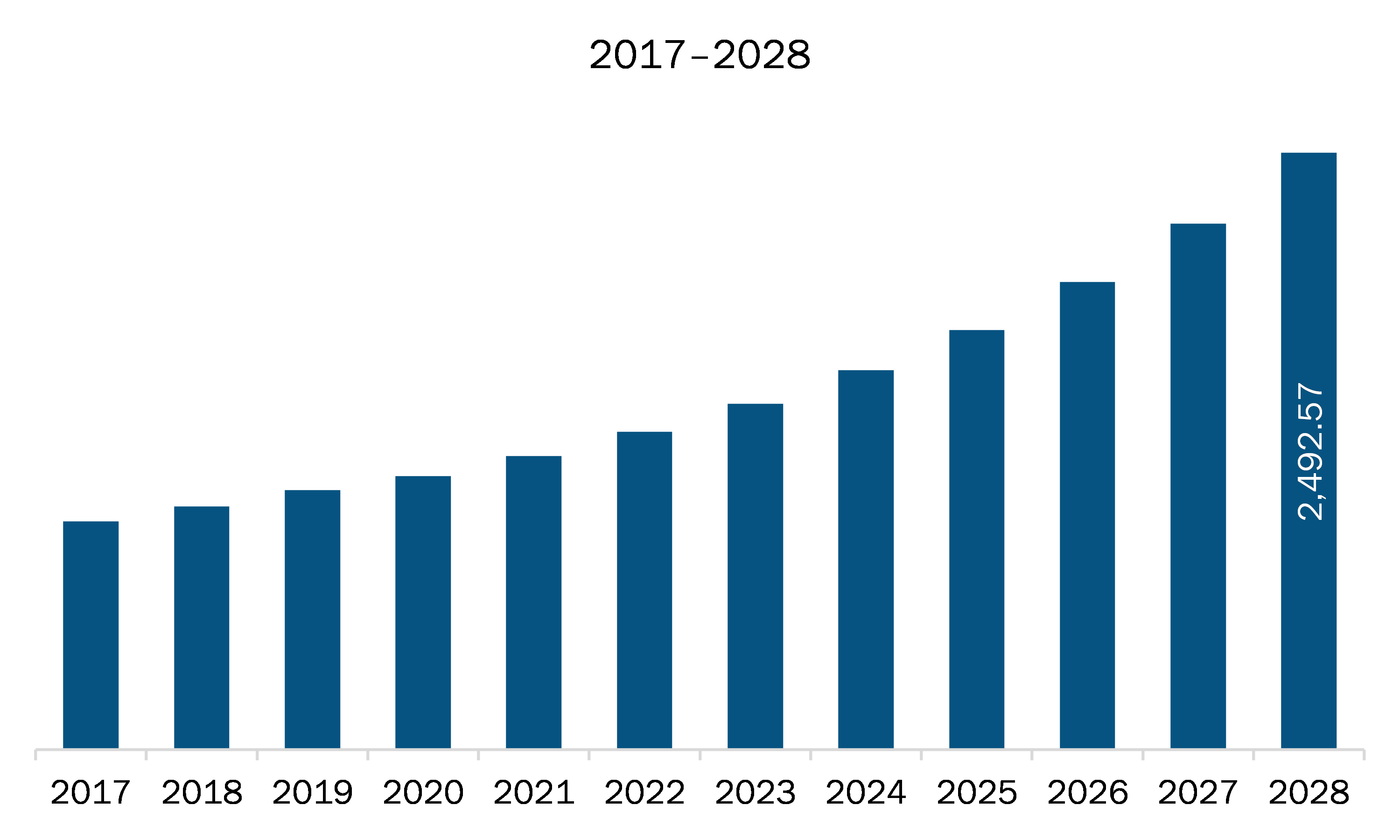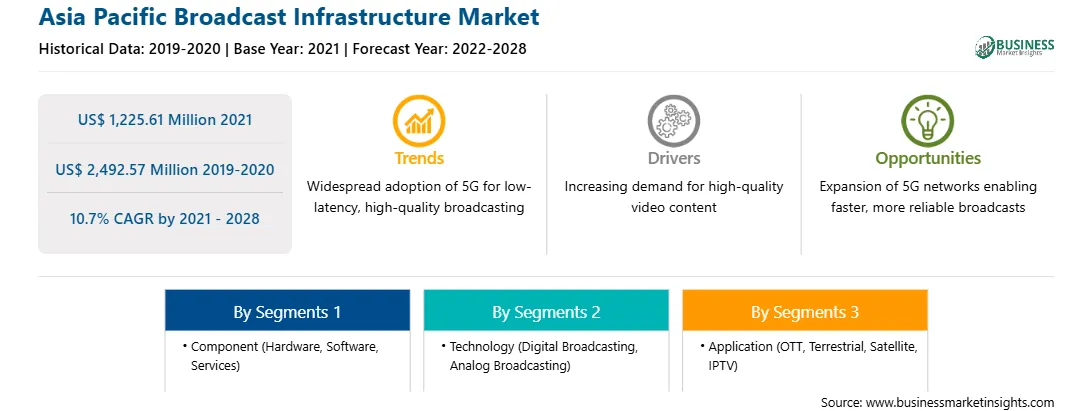The presence of steadily growing developing economies and the rising adoption of innovative as well as advanced technologies contribute to the fastest pace of the growth of APAC. Australia, China, Japan, India, South Korea, and the Rest of APAC are major contributors to the growth of the broadcast infrastructure market in this region. Rapid developments in technologies, digitalization of economies, and adequate support by governments are among the factors contributing to the smooth evolution of these economies from a developing to developed stage. The demand for advanced broadcast equipment and solutions is expected to grow substantially during the forecast period with the growing penetration of Internet-based and HD services (majorly in East Asian countries). Increasing inclination towards new viewing experience and growing popularity of digital platforms such as Netflix, Amazon Prime, and Hotstar among people are driving the broadcast infrastructure market in APAC. In Asia pacific region covering 22 countries comprising India, in the current scenario, the number of digital cable TV households is more than 350 million whereas the number of TV households for DTH and DTT are ~150 million and ~170 million respectively. DTT is anticipated to witness a positive growth trend in the near future. It is projected that by 2021, DTT is expected to become the second largest digital TV platform for serving the consumer after digital cable TV platform. Within the region, DTH is the leading multichannel platform by subscriber count in India, Australia, Malaysia, New Zealand, Myanmar, the Philippines and Sri Lanka. In the long-term scenario, while India is expected to continue to be the key driver for DTH growth in the region, the DTH market size is anticipated to shrink across various geographies, including Japan, New Zealand, Malaysia, and South Korea. Singapore has become a popular broadcasting base on account of its sophisticated digital infrastructure and high technological penetration. The shifts in consumer preference from full multichannel packages to flexible online video alternatives is the major factor that is stopping DTH businesses from growing in these markets.
In case of COVID-19, APAC is highly affected specially India. China is the most crucial manufacturer and industrial producer since it trades more manufacturing goods than any other country in the globe; it is also a world leader in several types of goods. According to the Organization for Economic Co-operation and Development (OECD), the other major economies outside of China have also impacted by the pandemic, such as huge South Korea, India, Australia, and Japan, and are experiencing downward growth. Since the outbreak of COVID-19 across the Asia-Pacific, several countries have suffered heavily. China, Japan, South Korea, India, Hong Kong, and Taiwan are some of the countries that have incurred a huge loss. The manufacturing sectors in the countries mentioned above have been experiencing low production and a weak supply chain. Additionally, the labor shortage has affected the manufacturing sector in these countries. The manufacturing facilities across industries are foreseen to revive substantial production volumes by 2021, which is anticipated again to create demand for advanced broadcast infrastructure. Hence, the overall impact of COVID-19 on APAC region is low to moderate.

Strategic insights for the Asia Pacific Broadcast Infrastructure provides data-driven analysis of the industry landscape, including current trends, key players, and regional nuances. These insights offer actionable recommendations, enabling readers to differentiate themselves from competitors by identifying untapped segments or developing unique value propositions. Leveraging data analytics, these insights help industry players anticipate the market shifts, whether investors, manufacturers, or other stakeholders. A future-oriented perspective is essential, helping stakeholders anticipate market shifts and position themselves for long-term success in this dynamic region. Ultimately, effective strategic insights empower readers to make informed decisions that drive profitability and achieve their business objectives within the market.

| Report Attribute | Details |
|---|---|
| Market size in 2021 | US$ 1,225.61 Million |
| Market Size by 2028 | US$ 2,492.57 Million |
| Global CAGR (2021 - 2028) | 10.7% |
| Historical Data | 2019-2020 |
| Forecast period | 2022-2028 |
| Segments Covered |
By Component
|
| Regions and Countries Covered | Asia-Pacific
|
| Market leaders and key company profiles |
The geographic scope of the Asia Pacific Broadcast Infrastructure refers to the specific areas in which a business operates and competes. Understanding local distinctions, such as diverse consumer preferences (e.g., demand for specific plug types or battery backup durations), varying economic conditions, and regulatory environments, is crucial for tailoring strategies to specific markets. Businesses can expand their reach by identifying underserved areas or adapting their offerings to meet local demands. A clear market focus allows for more effective resource allocation, targeted marketing campaigns, and better positioning against local competitors, ultimately driving growth in those targeted areas.

The APAC broadcast infrastructure market is expected to grow from US$ 1,225.61 million in 2021 to US$ 2,492.57 million by 2028; it is estimated to grow at a CAGR of 10.7% from 2021 to 2028. The broadcasting industry has been undergoing revolutionary innovations with technological developments to provide a better experience for users. Emerging technology and innovative workflows are transforming live production of events. The transition is mainly driven by standalone streaming services, linear over-the-top (OTT) providers, and companies such as Amazon, Facebook, and Twitter that are bidding for streaming rights. In the region, the shift toward digital video platforms and bidding from Amazon and Facebook for sports streaming rights are changing the sports landscape. The demand from users for personalized sports broadcast services will attribute to the growth of the market. Also, no. of companies are engaged in offering media services, software development, and system integration in the areas of radio, television, telecommunication & IT, and production & postproduction. In broadcasting industry, the live streaming services is gaining high momentum. Live streaming including major sports is becoming one of the biggest trends of a video distribution business in the region. Therefore, with dynamic evolution in technological innovation & consumption, it will contribute in live-streaming strengthening broadcast. With large proportion of pay TV operators and broadcasters, content creators & aggregators, OTT streaming companies, regulators & technologists, the penetration of broadcasting infrastructure will rise, which will drive the APAC market in coming years.
In terms of component, the software segment accounted for the largest share of the APAC broadcast infrastructure market in 2020. In terms of technology, the digital broadcasting segment held a larger market share of the APAC broadcast infrastructure market in 2020. Further, the terrestrial segment held a larger share of the APAC broadcast infrastructure market based on application in 2020.
A few major primary and secondary sources referred to for preparing this report on the APAC broadcast infrastructure market are company websites, annual reports, financial reports, national government documents, and statistical database, among others. Major companies listed in the report are Cisco Systems, Inc.; Dacast; EVS Broadcast Equipment; Grass Valley Canada; Kaltura; NEVION; and ROSS VIDEO LTD.
The Asia Pacific Broadcast Infrastructure Market is valued at US$ 1,225.61 Million in 2021, it is projected to reach US$ 2,492.57 Million by 2028.
As per our report Asia Pacific Broadcast Infrastructure Market, the market size is valued at US$ 1,225.61 Million in 2021, projecting it to reach US$ 2,492.57 Million by 2028. This translates to a CAGR of approximately 10.7% during the forecast period.
The Asia Pacific Broadcast Infrastructure Market report typically cover these key segments-
The historic period, base year, and forecast period can vary slightly depending on the specific market research report. However, for the Asia Pacific Broadcast Infrastructure Market report:
The Asia Pacific Broadcast Infrastructure Market is populated by several key players, each contributing to its growth and innovation. Some of the major players include:
The Asia Pacific Broadcast Infrastructure Market report is valuable for diverse stakeholders, including:
Essentially, anyone involved in or considering involvement in the Asia Pacific Broadcast Infrastructure Market value chain can benefit from the information contained in a comprehensive market report.